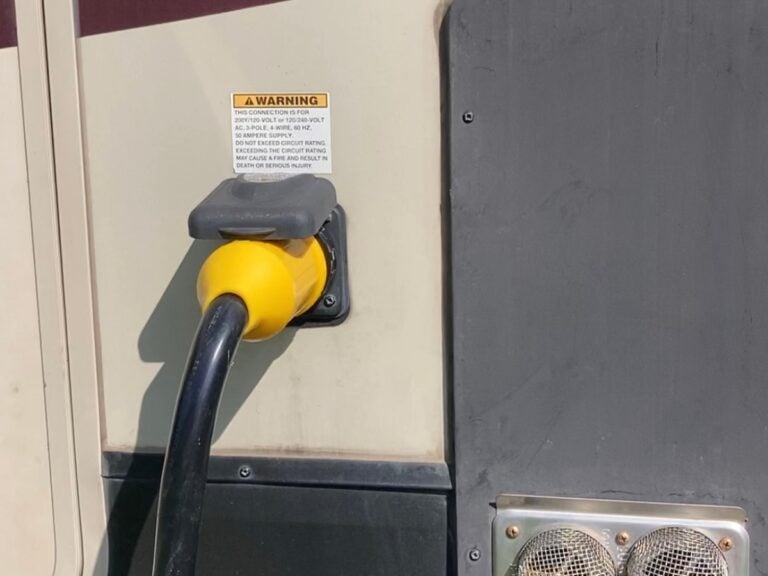This post may contain affiliate links. See our affiliate disclaimer here.
Imagine being stuck in the middle of nowhere with an incompatible RV plug that doesn’t connect to your campground’s electrical system – a freaking nightmare for any camper! Understanding the different types of RV plugs is more than just an electrical geek’s hobby; it’s the key to a seamless camping experience.
Dive into our comprehensive guide and get familiarized with every type of RV plug you’ll encounter on your travels, ensuring you’ll never be left powerless.
Contents
Basic Overview of RV Plugs
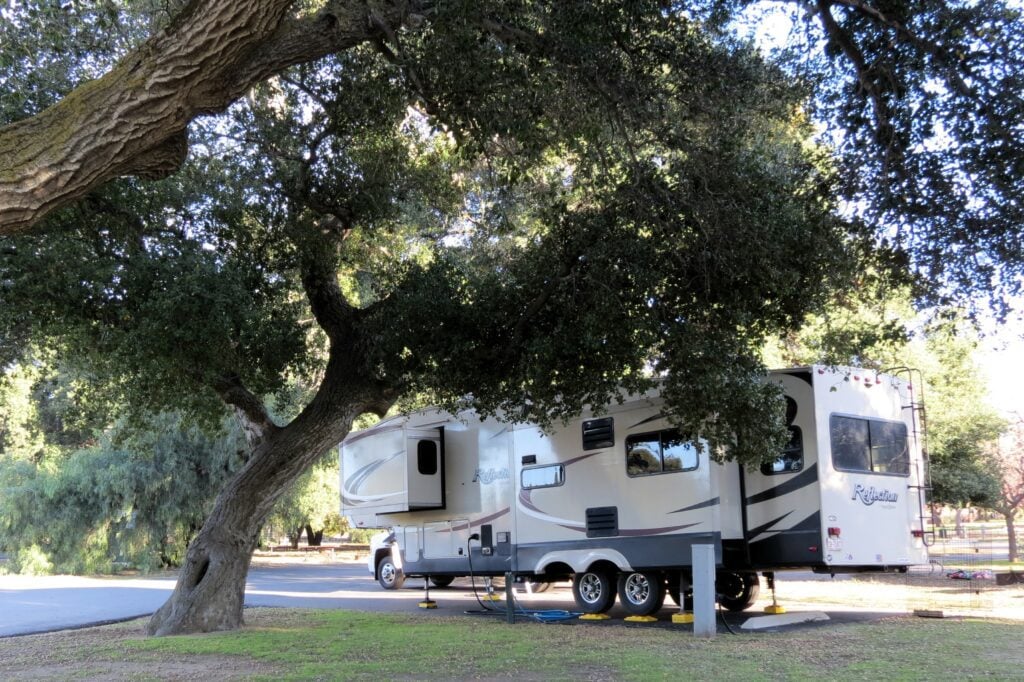
RV plugs are used to connect RVs to an external power source, usually campground power pedestals. The power provided to the RV through the plug is commonly referred to as shore power.
The RV’s electrical system is typically split into two parts: the 12-volt DC system, powered by batteries, and the 120-volt AC system, which operates on shore power.
Most RVs come equipped with either a 30-amp or 50-amp electrical system. This rating determines the type of plug and the amount of electricity your RV can draw from a shore power source.
Common Types of RV Plugs
Standard 120V AC Plug (NEMA 5-15 or 5-20)
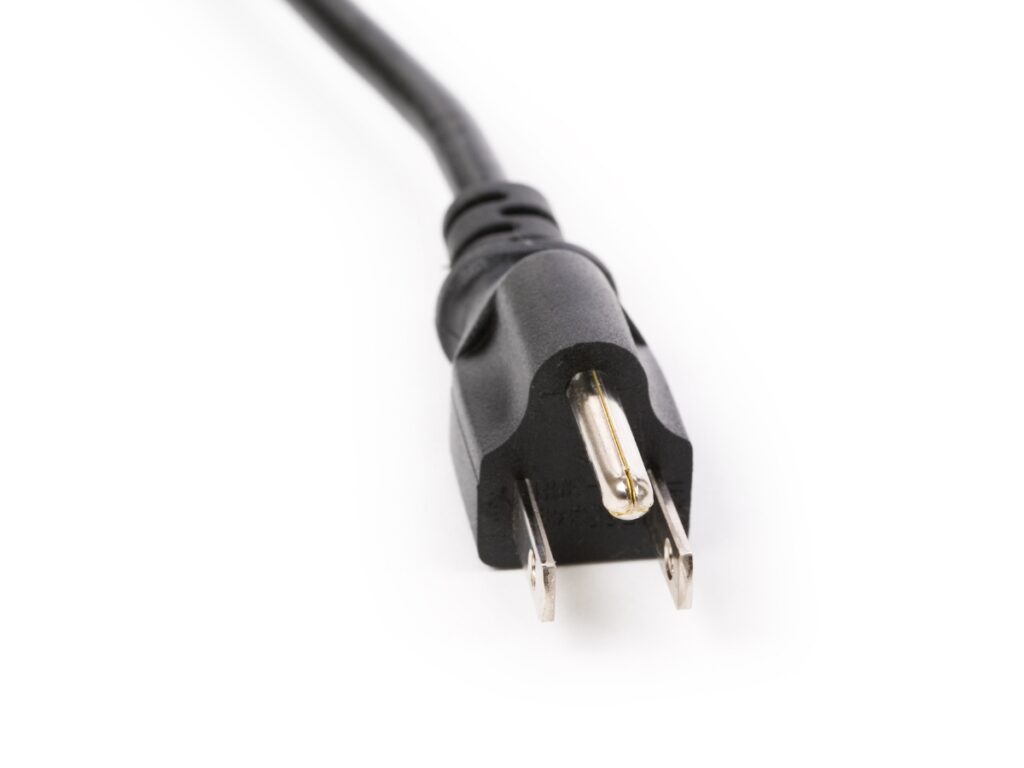
The NEMA 5-15 plug is the standard plug type you find in most residential homes in North America. It’s a three-prong plug, consisting of two flat parallel prongs and a grounding prong. This plug is sometimes used in smaller RVs for basic power needs and can handle up to 15 amps of power.
While the NEMA 5-15 plug is versatile and widely used, it has its limitations in the RV world. It cannot support high-power appliances like air conditioners or microwaves. Additionally, overloading a NEMA 5-15 circuit can lead to tripped breakers and potential electrical hazards.
30-Amp Twist-Lock RV Plug (NEMA TT-30)
A step up in the RV plug hierarchy is the 30-amp twist-lock plug, known technically as the NEMA TT-30. It’s designed to handle more substantial electrical loads, suitable for smaller to mid-sized RVs.
Typically RVs that have a 30-amp power cord only have one air conditioning unit, as it is typically not sufficient to run two units.
The twist-lock mechanism ensures a more secure connection, which is vital to prevent accidental unplugging, a common issue in outdoor settings. This plug type features a three-prong design, making it easily distinguishable from standard household plugs.
50-Amp Twist-Lock RV Plug (NEMA 14-50)
For larger RVs equipped with multiple air conditioners and other high-powered appliances, the 50-amp twist-lock plug, or NEMA 14-50, is the standard. This plug can handle up to 12,000 watts, making it suitable for almost any power demand in a large RV.
The plug has four prongs and includes a ground wire for added safety. It’s also designed with the twist-lock feature, ensuring a stable and secure connection to the power source.
Adapters for Different RV Plug Types
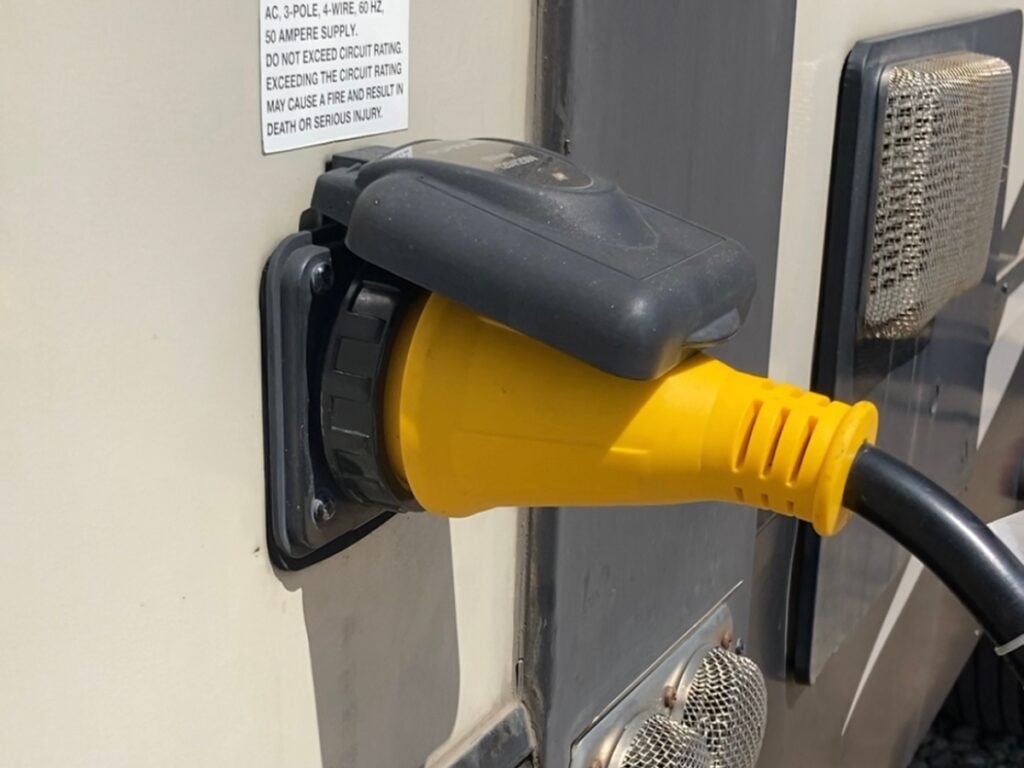
Given the variety of plug types and power sources you might encounter at different RV parks, carrying the right adapters and converters is essential. These devices enable you to connect your RV’s electrical system to a power supply with a different amperage or plug type.
For example, a 50-amp to 30-amp adapter allows an RV with a 50-amp system to connect to a 30-amp power source. When using an adapter, it is important to only use the amount of power appropriate for the lower amp rating.
If you have a 50-amp RV, but are using an adapter to plug into a 30-amp power outlet, you will only have the ability to use 30 amps.
Adapters 30-amp RV Owners Need
If you own an RV with a 30-amp plug, you should carry the following adapters, so you can plug into 15 and 50-amp outlets.
Adapters 50-amp RV Owners Need
If you own an RV with a 50-amp plug, you should carry the following adapters, so you can plug into 15 and 30-amp outlets.
Common Campground Power Pedestal Configurations
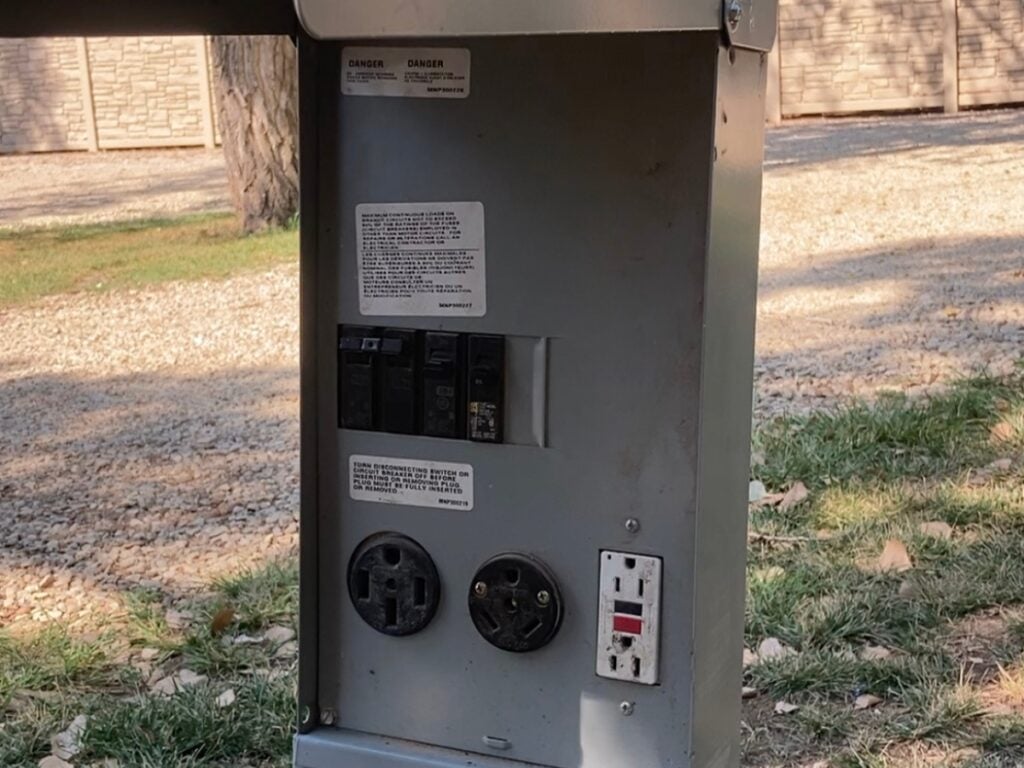
RV parks and campgrounds feature various power pedestal configurations to cater to different RV types. Most modern parks provide 30-amp and 50-amp hookups, as well as a standard 120V outlet.
However, some RV parks offer only 30-amp or 50-amp power outlets. Ask about the configuration at your destination when making a reservation and make sure you have the right adapters for the available power source.
How to Safely Use an RV Power Cord
Safety is a paramount concern when dealing with RV electrical systems. A thorough understanding and careful handling of RV plugs and power cords are essential to prevent accidents and equipment damage.
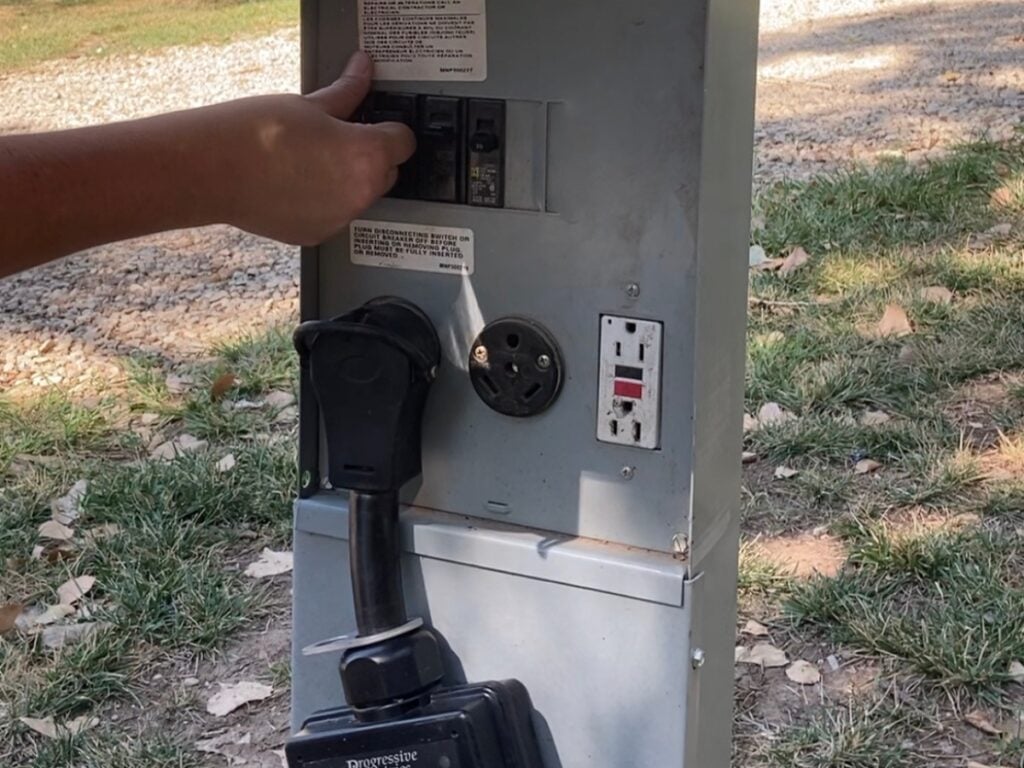
Safely Plugging in an RV Power Cord
When plugging your RV into shore power at a campground, follow the below steps to prevent damage to your power cord or electrocution.
- Inspect the Power Cord and Pedestal: Before plugging in, inspect the RV power cord for any signs of wear, fraying, or damage. Also, examine the power pedestal at the campground for any visible damage or irregularities.
- Turn Off the Pedestal Breaker: Before plugging in, ensure the breaker on the campground pedestal is turned off. This step prevents any unexpected surges of electricity during the connection process.
- Ensure Correct Plug Orientation: Make sure the plug aligns correctly with the pedestal outlet. Forcing a plug into an outlet can cause damage to both the plug and the outlet.
- Use a Surge Protector: Connect a surge protector to the campground pedestal first, and then connect your RV power cord to the surge protector. This device protects your RV from potential electrical surges.
- Secure the Connection: If you’re using a twist-lock plug, ensure it’s properly aligned and securely fastened. A loose connection can lead to arcing and overheating.
- Turn On the Pedestal Breaker: Once the cord is connected and secure, turn on the breaker at the power pedestal.
Are There 100-amp RV Plugs?
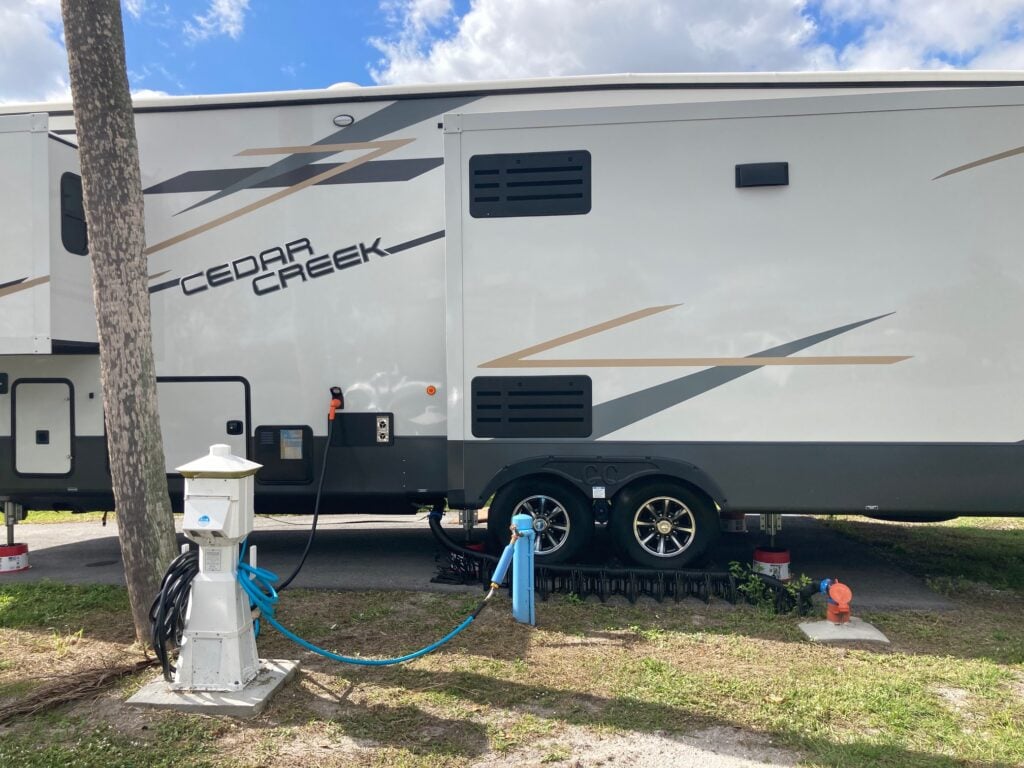
You may have seen RV resorts advertising 100-amp service, which leads many campers to believe that there are 100-amp RVs. However, this is not the case. Currently there are no RVs that offer 100 amp power cords.
When campgrounds advertise 100-amp, they simply mean the total of the available outlets is 100 amp. This could refer to two 50-amp outlets, or a standard RV power pedestal with a 50-amp outlet, a 30-amp outlet and a 20-volt outlet.
In summary, if you see an RV park offering 100-amp service, don’t worry. As long as you have a standard RV plug and the basic adapters, you will be able to plug in without any issues.
Are the Same Types of RV Plugs Used in Europe?
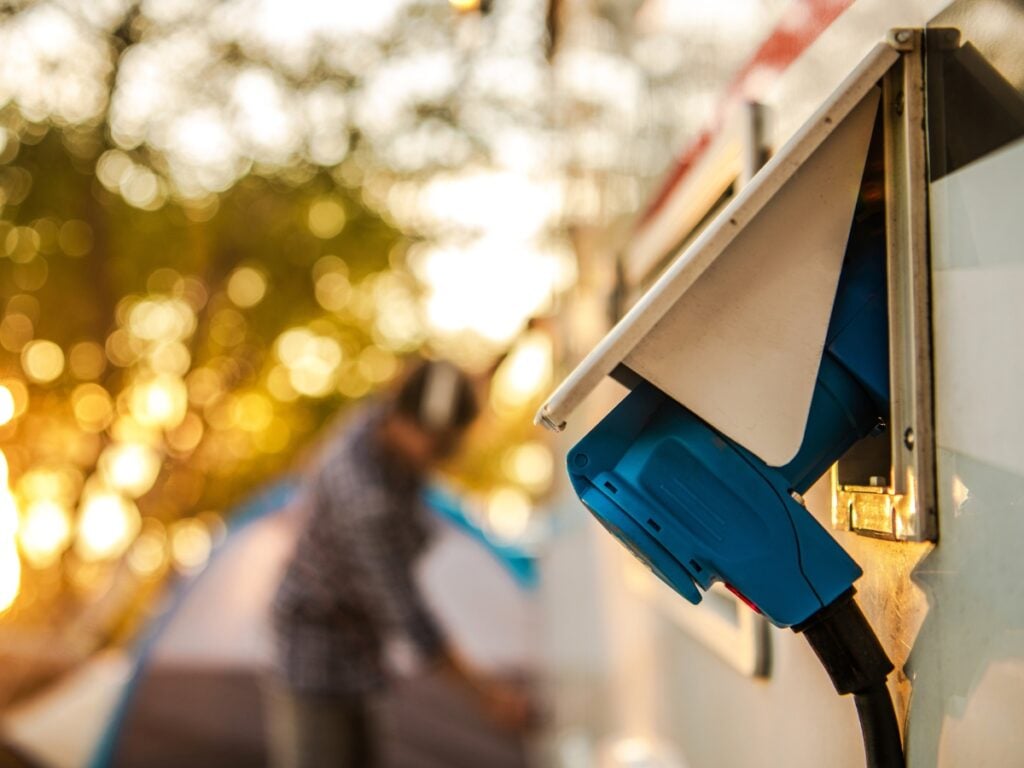
European RVs do not use the same plug types as travel trailers and motorhomes in the United States and Canada. The difference in electrical systems and standards between Europe and North America leads to distinct plug and voltage requirements.
RV plugs in Europe are typically rated for 16 amps and have three to five round prongs. The most common RV plug used in Europe is the IEC 60309 3-pin plug, which is commonly referred to as a blue plug.
Thanks for reading our guide to the types of RV plugs and power systems. We hope you feel more confident before heading out on your RV road trip.
Also make sure to download our free RV travel day checklist to help prepare for your trip.
Happy Camping!

Christina Pate is a seasoned full-time RVer who, along with her husband Justin, has journeyed across the US, Canada, and Mexico. Drawing from her extensive travels, RV repairs and RV renovations, she founded Travels with Ted to guide and inspire fellow RV enthusiasts. Christina is also the co-author of The Owner’s Guide to RV Maintenance and the creator of My RV Log Book.

